

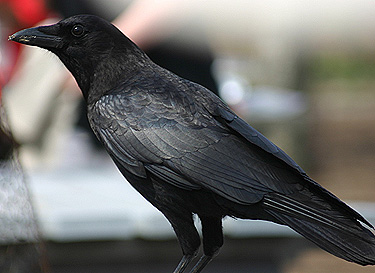
BIRDS
Pigeon
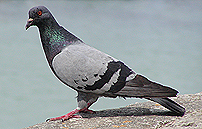 |
Height/Weight 12"-15" 10oz-16oz |
Flight Speed 28 to 82 mph |
|
| Range All fifty states Urban/ Suburban areas |
Habitat Protected ledges and roof-tops |
||
| Food Widely varied, grains, seeds, corn human food scraps |
Life Span 3-4 years in the wild up to 16 captivity |
||
| Effective Control Products 2" StealthNet, Birdwire, Bird-Flite, BirdCoil, Bird-Shock, Trapping |
|||
The feral pigeon is the number one urban pest bird. Large numbers exist in every city across the country. Not a native bird, feral pigeons are descendants of domestic homing pigeons brought over from Europe and released here in the 1600s. They were domesticated from the wild rock doves from the sea cliffs of Europe by the Romans over two thousand years ago. Several traits have allowed them to dominate the urban landscape. Because of their history, pigeons are not afraid of people; they roost and nest readily in man made structures and they have a diverse diet. The standard pigeon has a short neck with a small head. Their short legs with the level front and hind toes allow them to perch on branches as well as walk on flat surfaces.
The feral pigeon is generally blue-gray with a white rump; has iridescent
feathers on head and neck; two broad black bars across each wing and
a broad dark band across the end of the tail. They also can display
white, brown or gray plumage.
Feral pigeons are responsible for untold millions of dollars of damage each year in urban areas. The uric acid in their feces is highly corrosive. Also, debris from roosting flocks can build up, backing up gutters and drains thus causing damage to roofs and other structures. Extensive damage to air conditioning units and other roof top machinery is commonplace. There are also other economic costs that can be associated from pigeons taking up residence such as slip and fall liability and projection of an unclean, dirty company image. Besides physical damage, the bacteria, fungal agents and ectoparasites found in pigeon droppings sometimes represent a health risk.
Control
There are a wide variety of solutions available for handling a pigeon
infestation. The best solution for pigeon problems, is complete exclusion
with a 2" mesh StealthNet. Many ledge problems can be solved
by using products such as BirdCoil, Birdwire, Bird-Flite spikes,
as well as Bird-Shock electrical track. When bird pressure is heavy
in an area, exclusion work must be accompanied by flock dispersal
methods like trapping or use of moving predator effigies like the
Rotating Screech Owl. Flock dispersal alone is not a long term solution
especially in medium-heavy pressure situations like when there are
food/water/shelter sources at the site.
Nesting
Nest building is very simple and often consists of a few stiff twigs.
The male will pick the site. They prefer small flat areas away from
the ground. Look for nests along building ledges, bridge supports,
air conditioning units, window sills and the like. In crowded flocks,
pigeons will even forgo nest building and lay eggs directly on a
protected ledge.
Breeding
Pigeons are monogamous and a mating pair will typically have three
or four broods a year. The female will usually lay two or sometimes
three eggs at a time. The eggs are a solid bright white color. The
eggs take roughly 18 days to hatch and 35 more days before the fledglings
leave the nest.
Cycles
Pigeons are not migratory. Their natural instinct is to stay near their
birth site. This trait gives the pigeon a very determined personality
when it comes to roosting at a particular site, much to the dismay
of the inexperienced pest control technician. The daily cycle of
a pigeon is to roost at night, feed in the morning and loaf in the
afternoon. The seasonal cycle is as follows; courtship in the early
winter, nest building in late winter and breeding in the spring.
However, in warm climates, breeding will occur year round. Pigeons
molt once a year in late summer.
Starling
 |
Height/Weight 7.5"-8.5" 2-3oz |
Flight
Speed 18 to 40 mph |
|
| Range Across country rural to urban areas in increasing numbers |
Habitat Trees and building structures |
||
| Food Insects, wild fruit seeds and grain |
Life
Span 5 to 7 years in the wild up to 13 captivity |
||
| Effective
Control Products 1-1/8" Mesh StealthNet, Bird-Shock, fogging with ReJeX-iT, Flash Tape, Scare Eye Balloons or Octopus, Zon Guns, Bird Bombs & Screamers, Bird Wailer, Squawker, Bird-Gard |
|||
Like the house sparrow, the starling was introduced from Europe in the 19th century. It did not spread as fast and only reached the western coast within the last few decades. Starlings are well adapted to urban life which offer it an abundance of food and nesting sites. It is a muscular bird about eight inches long with long wings and a short squared tail. Starlings are very aggressive and will drive native birds out of their territory, much to the dismay of local bird watchers. Starlings are well noted for their flocking habits. They often gather in the tens of thousands, creating a nuisance when roosting in populated areas.
The starling is a dark chunky, muscular bird. It is distinguished from other blackbirds by its short tail and its longer, slender bill. Starling plumage varies depending on the season. In winter, the bird displays a highly speckled iridescent coat and a dark bill. In summer, the bird's coat dulls and has far fewer speckles.
Damage
Starlings rank just behind pigeons and sparrows as an urban bird pest.
Starlings can be a nuisance in both urban and rural areas due to their
nesting, eating and living habits. When the bird is in its flocking
phase, thousands of starlings often overwhelm buildings and trees.
Large scale buildup of feces from these flocks can lead to structural
damage. The uric acid in the feces can corrode stone, metal and masonry.
Gutters and drainage pipes clogged with starling nests often backup,
causing extensive water damage. The bacteria, fungal agents and parasites
in the feces also pose a health risk.
Control
Starlings roosting habits can be modified permanently using 1-1/8" mesh
StealthNet and/or electrical systems like Bird-Shock. For large flocks
or agricultural applications, these birds can be moved with a well-timed,
organized scare campaign using strategically placed sophisticated audio
systems like the Bird Wailer, Squawker, or the Bird-Gard units depending
on the size of the area. These products combine natural and electronic
sounds like species specific distress calls, predator hunting/attack
sequences and canon or shotgun sounds. Other noisemakers such as Zon
Guns and Bird Bombs & Screamers often have success in relocating
these bird when combined with lights and visual frightening devices
that flash such as Flash Tape, Scare Eye Balloons or Octopus. A new
technique that has found some success for moving populations from trees
is to fog problem areas with ReJeX-iT.
Nesting
The Starling is a nesting bird. Their nests are in enclosed areas with
at least a 1-1/2 inch opening. Look for their nests in old trees,
church steeples and other holes and crevices. Due to their bullying
nature they will take any suitable site, evicting any previous owner.
They sometimes watch other birds build a complete nest before forcing
them to leave.
Breeding
Starlings have two broods a year with four to five eggs a brood. They
average eight offspring a year. The eggs are white, pale blue or
green-white. Incubation of the eggs takes twelve days. The fledglings
leave the nest after 25 days. The young leave to join other juveniles
and form huge flocks that move on to other territories.
Cycles
Not a true migrating bird, starlings may move from rural trees to warm
city buildings in winter. The daily cycle is one of leaving the nest
at sunrise to travel up to sixty miles to feeding areas before returning
for the evening. They disperse to mate in the spring. After mating
season, they will often coalesce into huge flocks with defined feeding
and roosting areas.
Sparrow
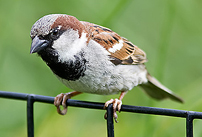 |
Height/Weight 5"-6" 1oz |
Flight
Speed 5 to 39 mph |
|
| Range Across country rural to urban areas |
Habitat Trees and building structures |
||
| Food Seeds, grains insects and fruits |
Life
Span 1-2 years in the wild up to 10 captivity |
||
| Effective
Control Products 3/4" StealthNet, Bird-Shock, Trapping, fogging with ReJeX-iT |
|||
The House sparrow is the number two urban pest bird. Introduced as a species to North America, the house sparrow quickly spread across the country due to its lack of natural enemies and its adaptive traits. Its ability to nest in urban structures, eat urban scraps and a large breeding capacity are some of these adaptive traits. The House Sparrow is actually a member of the weaverbird family and not a true Sparrow. Weaverbirds create intricate nests and relative to their size, the largest nests in the bird world. Their legs and toes are favored for branch perching and their short conical bills are ideal for seed cracking. Their diet consists of seeds and grain, as well as fruits, vegetables, human table scraps and insects. They are boisterous, intelligent birds who roost in noisy flocks on branches of city trees, ivy covered walls and under eaves of houses.
Male House Sparrow have black throats and chest patches, light cheeks
and brown nape. The female has a plain brownish chest and dull eye-stripe.
Damage
House Sparrows are often a nuisance in urban areas like manufacturing
and food processing plants. Gutters and drainage pipes clogged with
sparrow nests can backup and cause extensive water damage and fires
have been attributed to electrical shorts casued by machinery housing
sparrow nests. Lastly, feces buildup can lead to structural damage
from the uric acid in droppings, plus the bacteria, fungal agents
and parasites in the feces also pose a health risk.
Control
The most effective method of control is to exclude sparrows from the
area with 3/4" StealthNet, making sure there are no gaps or
crevices for the birds to pass through. The only ledge deterrent
systems that are truly effective against sparrows are electrified
ledge systems that use an intermittent pulse like Bird-Shock. New
2-chambered Sparrow Traps are quite effective at trapping small quantities
of sparrows. The best trap has an elevated second chamber that keeps
the birds happy and so content that they actually sing, attracting
others to the trap. When practical, the trapping program should be
combined with a nest removal program that will greatly reduce the
population over time. Along with trapping, mist nets can be installed
in the flight paths by certified personnel to capture these birds
in enclosed areas. A new technique that has found some success for
moving populations is to fog problem areas with ReJeX-iT. This method
is most commonly applied when sparrows gather in flocks. Sparrows
generally do not react to audio and visual products except occasionally
in areas to which they are not very committed (new to area).
Nesting
They build large nests relative to size which function as the center
of all activity. They prefer small enclosed places such as house
shutters, drainage piping, building rafters and corrugated metal
siding. They will build a spherical nest in a tree or another exposed
place if they have no other option. The building material will be
sticks, with an inside lining of grass, string, fabrics or straw.
The nest will often hold several families.
Breeding
House sparrows only mate for a season. They average three broods per
mating season with each brood containing four to seven eggs with
20 offspring a year average. Egg coloration will be white, pale blue
or pale green with a few gray or brown dots. If unchecked, a breeding
pair can grow to over 2,000 birds in two to three years.
Cycles
House Sparrows are not migratory, but in cold climates can show movement
between rural/suburban breeding sites and warmer winter roosting
sites in the city. House Sparrows are aggressive birds and will often
force out other birds from their territories. They are flocking birds
and will gather in the thousands to take over feeding and roosting
areas.
Crow
 |
Height/Weight 18"-21" 15oz-22oz |
Flight
Speed 25-32 mph |
|
| Range Continental U.S. Suburban/ Rural areas near water |
Habitat Tall trees and buildings 20 to 100 feet up |
||
| Food Scavenger, eats almost anything: insects, snakes, dead animals, human food scraps, eggs and garbage |
Life
Span 6-7 years in the wild up to 20 captivity |
||
| Effective
Control Products 2" StealthNet, audio/visual scare devices, 5” Bird Coil, Bird-Flite, Birdwire, Bird-Shock, fogging with ReJeX-iT |
|||
There are two main species of Crows, the large common crow found across the country and the smaller fish crow found in the Southeast. The Common Crow is a big black colored bird approximately 17 to 20 inches long with a strong stout build and a compressed bill. The Fishing Crow is a smaller darker version of the Common Crow. Both have a scavenger's diet and will eat a wide variety of things. Such food items include insects, frogs, small snakes, eggs, mice and dead animal carcasses. Crows will also eat newly planted crops such as corn. Crows are well known for their intelligence. They are social birds and the flock is in constant communication making hunting or capture of the bird very difficult. The Crow's native history along with its helpful bug eating habits have insured its Federally protected status.
The Crow is black from bill to tip of wing and claws with a metallic
violet gloss on body and a blue-violet/green-blue gloss on wings. Adults
have black eyes while juveniles have blue eyes.
Damage
Crows are frequently a big agricultural pest bird due to their fondness
for corn and other farm crops, but they are a minor urban pest compared
to the pigeon, starling or house sparrow. These birds can overwhelm
trees, creating a lot of noise and harassing people and animals in
the vicinity which can be a nuisance to the suburban resident. Furthermore,
like any pest bird, dropping buildup can lead to structural damage
from the uric acid while also posing a health risk due to the harborage
of disease.
Control
It is possible to drive away large flocks of crows and other blackbirds
with audio/visual scare devices such as the Bird-Gard unit combined
with visual scare devices like Scare Eye Balloons, Octopus and Flash
Tape. To maximize effectiveness, hang visual products in trees before
commencing noise campaign. They can be kept off ledges using 5” Bird
Coil, Birdwire, Bird-Flite spikes or Bird-Shock electrical track.
Two inch mesh StealthNet will exclude crows completely from most
areas. Advanced predator kites like the Avikite and fogging with
ReJeX-iT are new effective deterrent methods that can be effective
against crows.
Nesting
Crows are committed nest builders. They typically build nests in trees,
twenty to sixty feet off the ground. The nest consists of sticks
and twigs with shredded bark, grass or a similar material lining
it.
Breeding
Crows have one or two broods a year, averaging four to seven eggs per
brood. Incubation takes eighteen days with a four to five week fledgling
period before the young leave the nest. The eggs range from pale
bluish-green to olive green or greenish-brown with splotches of brown
and olive-gray.
Cycles
Migratory in upper parts of the country. Northern birds will fly thousands
of miles south during the winter, while southern birds stay put year
round. One notable characteristic about crows is their flocking behavior.
In fall and winter they will move to better feeding areas where they
will coalesce into massive feeding flocks. These feeding flocks in
turn, join up with other flocks at night to form enormous communal
roosts numbering from a couple thousand to tens of thousands.
Grackle
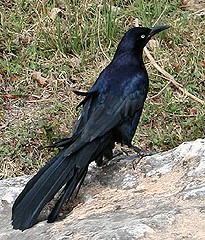 |
Height/Weight 12"/6oz common 16"/7oz boat-tailed |
Flight
Speed 20 to 35 mph |
|
| Range Common Grackle: Across U.S. BoatTailed Grackle: Along Atlantic coast and Gulf of Texas seaboard |
Habitat Prefer suburban areas with access to open areas. Roost in large trees during the winter. |
||
| Food Scavenger. Eats grains, seeds, corn, insects, food scraps, etc. |
Life
Span 8 to 12 years in the wild |
||
| Effective
Control Products 1-1/8" Stealth Net, Bird-Shock, Audio/Visual scare deterrents, fogging with ReJeX-iT |
|||
Grackles are boisterous, abundant members of the Troupial Family. Also members of this family are the blackbirds, cowbirds and orioles. Common grackles are found all across the mid-west and east coast. Boat-tailed grackles live along the eastern and southern seacoasts while great-tailed grackles are found mostly in Texas and the south-west. Grackles are aggressive birds who will colonize in large numbers. These birds are very noisy, their gregarious nature is very apparent when observing their roosting and nesting sites.
The common grackle has a green/blue or purple iridescent tinted black
plumage with a glossy purplish head, neck and breast with the female
of the species, slightly smaller and duller colored. Boat-tailed and
great-tailed grackles have very long "v" shaped tails which
crease in flight, hence the name "boat-tailed". They are
similar in color to the common grackle but are larger birds (16 inches
long versus 12” long). Female great-tails resemble the males while
female boat tails are dark brown in color Great tails differ from boat
tail grackles with their bright yellow eyes and more uniform color.
Damage
Grackles can cause several types of damage. As they are scavenging
birds, large numbers can be found at dumpsites, food courts and other
human areas where food is present. The resulting amount of fecal matter
creates unsanitary conditions and can result in physical damage from
the uric acid. They are also an agricultural pest bird because they
will eat small seedlings and damage crops.
Control
There are numerous products and techniques available to combat nuisance
grackles. Like fellow members of the blackbird family, noisemaker
units such as the Bird-Gard, Bird Squawker and Bird Wailer units
projecting natural distress calls and frightening sounds (selection
of units depends on size of area to deter birds as well as severity
of problem) plus visual scare products like Scare Eye Balloons, Octopus,
Flash Tape and the Avikite can be used to move them from a site.
If they are too entrenched to be scared away, exclusion using 1-1/8" Stealth
Net or Bird-Shock electrical track on ledges will be necessary. Grackles
are too nimble for traditional mechanical ledge products. Fogging
a roosting winter flock with ReJeX-iT irritant has also shown some
success.
Nesting
Grackles build a bulky yet dense nest of twigs, grasses or weeds lined
with feathers, rags or dried grass. The nest may be held in place
with a foundation of mud or cow dung. Grackles will nest in a variety
of places from willow swamps, dense brush to tall trees with trees
being the most common. Boat tail grackle nests will seldom be seen
more than twenty miles from the coast.
Breeding
Grackles breed during the spring. They usually lay four to five eggs
in a single brood for the year. Common grackle eggs are a pale green
to light brown with purple and dark brown streaks and blotches. Boat
tailed grackles have lighter blue to grayish eggs with dark streaks
and blotches. The eggs take 14 days to incubate with the young being
able to fly about three weeks later.
Cycles
Grackles have a definitive seasonal behavior. They nest and breed as
one pair or in small groups in the spring time. In the fall, the
birds will fall to form large colonies with the juveniles first forming
the groups and later joined by the adults. These large colonies can
number in the thousands. In colder, northern climates the flock will
migrate south, while southern birds will stay put or move into a
more urban location. These flocks will usually take over several
trees or urban dwellings for their evening roosting. In the winter,
their feeding site may be quite far from their roosting spot, making
trapping or baiting difficult.
Goose
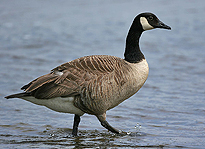 |
Height/Weight 22" to 48" 3-4 lbs. to 24lbs |
Flight
Speed 20 to 55mph |
|
| Range All fifty states rural to urban areas |
Habitat Grassy fields near water |
||
| Food Graze on marsh grass, pond weeds, new grain and corn |
Life
Span Generally 10-25 years; some instances 40+ |
||
| Effective
Control Products Gridwire, 4" StealthNet, audio/visual scare devices, ReJeX-iT, wire perimeter fences with Flash Tape |
|||
By definition, Canada geese are not classified as pest birds and are afforded protection by Federal & State agencies. Nonetheless, Canada Geese are increasingly becoming the scourge of suburbia as their numbers have grown in the past decade from only a few thousand to hundreds of thousands of these birds. In fact, the familiar V shaped squadron of honking geese heading south is becoming a rare sight. Country Clubs and business parks offer pristinely manicured lawns and ponds providing an ideal habitat and effectively modifying their migration cycle. Geese are very opportunistic and easily exploit the new 'easy living' conditions found in an urban environment.
There are at least 10 or 11 subspecies of Canada geese, all similar
in color pattern with long black neck and head with large white cheek
patches meeting under the throat. The birds' brown-gray body has a
pale to dark breast and underparts while the black tail has white upper
and undertail coverts. The bill and feet are also black. The bird varies
in size from 22 to 48 inches long and weighing in from 3-4 lbs. all
the way up to 24 pounds.
Damage
Geese can cause damage to agricultural crops year round, either by
trampling or consumption. Aesthetic damage to suburban lawns, golf
courses, etc., is incalculable. Geese are also a health hazard- fouling
reservoirs and ponds. A larger threat is air safety. Geese are one
of the main birds involved in airline bird strikes worldwide.
Control
Non-migratory Canada geese are difficult to remove. Once established,
immediate corrective landscaping and behavioral modification is imperative:
Remove cover shrubbery; use herbicides to eliminate aquatic vegetation;
and reduce fertilizer, especially around pond area, to make grass
less nutritionally attractive. Several visual scare products like
the Goose Guard and Flash Tape combined with ReJeX-iT taste deterrent
should be employed as soon as the birds enter the area, varying in
location and type. For more established flocks audio scare devices
like Zon Guns, Scare Streamers, the Bird-Gard or Bird Squawker units
that project a variety of sounds through several speaker locations
in a random pattern should be set up at strategically placed intervals.
All systems require constant re-enforcement and should be relocated
frequently, especially the Goose Guard units to remain a convincing
threat to the birds. Physical barriers such as overhead Gridwire
and 4" mesh StealthNet can be extremely effective barriers but
are site specific. These grids can be installed above water surface
to prevent landing. Fencing made of Gridwire (.96mm) provides a discrete
barrier to dissuade geese from entering property (especially from
water areas) and can be electrified for increased effectiveness.
Wire fencing applications should begin approximately 1' off the ground
with successive strands approximately 1" above the last to a
height of at least three feet. Four inch mesh StealthNet with 1/2" reflective
Flash Tape hanging from it can also be utilized above and around
ponds and grassy areas.
Nesting
Nesting sites are typically near water with protective vegetation in
close proximity. Planter boxes on high rise office building balconies
in campus like settings are quickly becoming a nesting site of choice.
Geese are extremely aggressive, posting sentinels at nesting and
grazing sites. Defense of nests can many times result in injury to
people or pets who venture too close.
Breeding
Female geese usually lay one egg every other day during the 25 day
spring mating season. The nest is abandoned a few days after hatching.
Canada geese are monogamous for life, but will re-mate upon the death
of their mate.
Cycles
Non-migratory or residential geese, once established, prefer feeding
at the nesting site, but will often fly long distances to and from
favorite feeding grounds. Some feeding may occur during moonlit nights.
Turkey Vulture
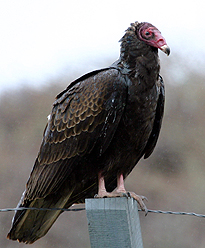 |
Height/Weight 26"-32" (wingspread= 68"-72") 3-6 lbs. |
Flight
Speed 15 to 34mph |
|
| Range All 50 states but mostly in southern half of U.S. |
Habitat Caves, cliffs, hollow logs |
||
| Food Carrion, fresh to putrid |
Life
Span Approx. 20 years |
||
| Effective
Control Products StealthNet, heavy duty Birdwire, Bird-Shock, Gridwire, BirdWailer, Squawker, and fogging with ReJeX-iT (limited applications) |
|||
The Turkey Vulture won't win any beauty contests. The birds’ shape
and head look similar to a Turkey, with a red head and dark body
feathers. This large bird lives all across the U.S. The small featherless
head is ideal for foraging inside of dead animals, like alligators,
raccoons, and opossums. They generally hunt their prey by hovering
about 200 feet above the ground. Although the turkey vulture generally
migrates, it may stay put during mild winters. They generally live
over open plains, desert or forest. Groups of up to 70 or more may
roost in trees and towers, and leave when the warm, rising air makes
it easier to fly.
The turkey vulture features a bald head with reddish skin similar
to that of a turkey. They are large birds weighing up to six pounds,
with a wingspan up to 32 inches. Their long, slim tail and long wings
enable it to soar on wind currents with little effort. Surprisingly,
when taken in as young birds, they can be loyal and charming pets.
Damage
The damage caused by these birds can be impressive. They are known
to attack roofs, caulking and other exterior surfaces causing extensive
damage, and leave bones and carcasses in unpleasant places. Being a
large bird, their dropping is significant and can build up quickly
if a large flock is present creating a serious health risk. They also
have a reputation of being a noisy bird, especially when fighting over
food or hanging out in a large group.
Control
All members of the vulture family are protected under the Migratory
Bird Treaty. This is a heavy, aggressive bird that can literally
destroy many standard control products. The most effective methods
of control are electrified heavy duty wire systems like BirdFence
(call our offices for more details on this product) or Bird-Shock
electrical track products. In some instances heavy duty .96 mm wire
tensioned 8” high similar to Birdwire will protect against vultures
roosting on roof parapets or girders. Ridge brackets and adjustable
clamps are specifically designed to serve as a passive deterrent
system at the appropriate architectural detail. This Birdwire system
can also be easily electrified to increase effectiveness. Overhead
Gridwire systems 5’ on center or horizontal nets can dissuade these
birds from flat roofs. Specifically designed sound systems employing
electronic noises emanating from different speakers at varying intervals
like the Bird Wailer or Squawker should be used in conjunction with
other control methods. Fogging agents that assault the birds’ nasal
and oral cavities like ReJeX-iT must also be used on a random basis.
Nesting
They do not build traditional nests like other birds, simply laying
their eggs on the bare floor of a cave or other protected enclosure.
Sometimes they even lay their eggs inside rotten trees, trunks, logs,
on the ground inside dense shrubbery, or even on the floors of abandoned
buildings. After laying the eggs, both adults may roost in the nesting
cavity and, if surprised in the nest, may regurgitate decomposing
food or play dead.
Breeding
Pairing is usually preceded by a group “dance” where each bird hops
towards its neighbor, which then hops towards another. They generally
breed between February and June, laying one to three dull-white to
cream-white eggs. Eggs are often spotted or blotched with brown.
Both sexes usually incubate for 38 to 41 days. Fledglings are fed
by regurgitation.
Cycles
Turkey Vultures migrate as far south as South America for the winter,
and as far north as Canada for the summer. They are also found in
the Bahamas and the West Indies. As indicated above, they may not
migrate if the weather is pleasant, and they have an hospitable environment.
Gull
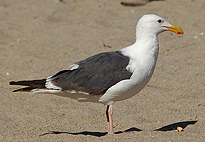 |
Height/Weight 18"-26" 25oz-38oz |
Flight
Speed 15 to 38 mph |
|
| Range On the ground along safe, secluded areas |
Habitat Near large waterways |
||
| Food Scavenger. eats fish, crab, insects, forages at dumps, harbors and waste sites |
Life
Span 8-10 years in the wild up to 30 years in captivity |
Gulls and other related sea birds exist in great numbers along coastal areas, large lakes and rivers. A subset of long winged swimming birds, there are 45 species of Gulls. Twenty species are resident (nesting) in North America and four are visitors (non-nesting). An intelligent bird, they will carry mussels and clams high in the air and drop them on hard surfaces to get to the soft meat inside. Gulls have the ability to drink saltwater and freshwater, thanks to a pair of salt removing glands above their nostrils. They are good swimmers who can walk or run agilely on land. Gulls are scavenging birds; they will eat everything from dead fish and garbage to field mice and insects. Gulls enjoy protection at the federal, state and local levels.
The typical Gull has a light colored body with black wing tips and
a dark mantle that can range from deep black to light gray. Their coloring
can change between seasons. Juveniles are usually brown with a dark
band on the tail.
Damage
Gulls can be a nuisance in coastal areas, particularly at dump sites,
piers and harbors. Flocks of gulls often create hazardous conditions
to low flying aircraft. Large buildup of droppings will lead to structural
damage from the uric acid. Boats, streetlights and buildings are just
a few of the items damaged from excessive gull droppings. Furthermore,
their droppings can also pose a health risk.
Control
Gridwire systems and large 4" mesh StealthNet will deny access
to large open areas. Bird-Flite spikes, 5" Bird Coil, and Bird-Shock
electrical track are very effective on ledges depending on the level
of bird pressure. The
Daddi Long Legs is a great product to dissuade gulls from landing on
silos, street lights, A/C units & large flat rooftops. For feeding
sites such as dumps, a wide variety of audio/visual products like the
Avikite or Flying Osprey and noisemakers like Zon Guns, Bird Bombs
and Screamers, or high tech multiple and random sound distress call
units like the Bird-Gard, Squawker or BirdWailer units should be combined
with exclusionary products such as Gridwire systems or 4" StealthNet.
Nesting
Gulls build basic nests on the ground in safe open areas. The nest
often consists of grass, seaweed and some sticks. They nest in colonies
on sandy or gravely areas near the shore.
Breeding
These birds have one brood a year with an average of three eggs. Incubation
takes 20 to 24 days with a six week fledgling period before the young
leave the nest. The eggs are brown, green or blue with blotches of
black, brown or gray.
Cycles
Some species are migratory. Gulls need open water and secluded breeding
areas. Because of this, Northern Gulls will fly south away from frozen
lakes and rivers in the winter, while southern gulls stay put year
round. They have a distinct springtime breeding season. The young
take two years to mature and display adult plumage.
Woodpecker
 |
Height/Weight 7" to 15" 1-1/2oz to 16oz |
Flight
Speed 20 to 44mph |
|
| Range All fifty states mostly suburban areas |
Habitat Trees, wood siding, telephone poles, fences |
||
| Food Insects, fruit, nuts, seeds, tree sap |
Life
Span 5 to 12 years depending on species |
||
| Effective
Control Products 3/4" StealthNet, or audio/visual/taste deterrents like Protective Coating Spray, Hole Filler or Paint Additive with Bird-Gard unit, and Scare Eye Balloons, Octopus, or Flash Tape (multiple types of deterrents should be utilized against these determined birds) |
|||
There are over 200 different species of woodpeckers worldwide, 23 of which can be found in the United States. The woodpecker is most commonly found in wooded regions of the country, where they can cause damage to the exterior of wooden buildings and houses. The Woodpecker’s unique body is designed to easily cling to tree trunks, branches, wood siding, or utility poles while pecking for food. Pecking or “drumming” against trees or buildings is the characteristic most associated with Woodpeckers. They do this to establish territories and to attract or signal mates. Woodpeckers primarily feed on tree living or wood-boring insects using their strong beak and long tongue to dislodge food. Some members of the Woodpecker family (Flickers) feed on insects of the ground, while others prefer native berries, fruit and nuts.
Woodpeckers are 7 to 15 inches in length, and usually have brightly
contrasting coloration. Most males have some red on the head, and many
species have some black and white marks. The woodpeckers have short
legs with two sharp-clawed, backward-pointed toes and stiff tail feathers,
which serve as a supportive prop.
Damage
Woodpeckers can be a nuisance in wooded regions of the country, primarily
from the drumming sound they produce when pecking at the sides of homes
and businesses. This can be quite annoying, especially in the early
morning when the occupants are trying to sleep. They can also cause
significant damage to the sides of buildings, telephone poles, eaves,
fences, etc., by pecking holes into the surface. The holes are usually
caused by 1 or 2 birds during the spring time mating season.
Control
All Woodpeckers are protected by the Federal Migratory Bird Treaty
Act. The most effective control method is 3/4” StealthNet that can
be installed in a semi-permanent configuration until nesting behavior
has been permanently modified. Alternatively, taste deterrents like
the Protective Coating Spray, Hole Filler or Paint Additive combined
with audio/visual scare tactics such as Bird-Gard distress call units,
Scare Eye Balloons, Octopus, and Flash Tape have been effective,
especially if used when the problem first arises.
Nesting
They select their homes near wooded regions because of their dependence
on trees for food and shelter. Woodpeckers use their strong beak
to bore holes into tree limbs or trunks when carving out a place
to live. They prefer to live in dead trees and show a tendency to
build on the side of the structure that receives the early morning
light and warmth from the rising sun. They can also be found living
in man made structures, such as wooden fence posts, utility poles,
and buildings. The loss of old growth trees has accelerated their
use of man made structures for homes.
Breeding
Woodpeckers breed in the spring, commonly laying 2 to 8 dull white
or glossy eggs. The incubation period lasts from 11 to 14 days and
maybe longer for larger Woodpeckers. They typically have 2 broods
per year with some species bearing eggs 3 times per year. Eggs are
watched over by both parents during incubation.
Cycles
Very few species of Woodpeckers are migratory, although some species
show movement southward in winter or from higher mountains to warmer
lower valleys. In general, cold weather is not a problem because
of the availability of their food supply under bark or in dead or
rotted wood where it is out of reach of most birds.
Cliff and Barn Swallows
 |
Height/Weight 5"-6" 1 oz |
Flight
Speed 15-45 mph |
|
| Range Across country rural to urban areas |
Habitat Suburban areas adjacent to open fields and water |
||
| Food Well noted insect eater |
Life
Span 4-6 years in the wild up to 12 in captivity |
||
| Effective
Control Products 3/4" StealthNet, angled and staggered Birdwire systems, Bird-Shock Flex-Track |
|||
These slender, sleek birds are well known for their long migration and nesting habits. Cliff and barn swallows spend their winters in South America and summers in North America. They arrive around March in the southern part of the country, reaching the northern states in April. They are very territorial and will always come back to the same nesting site. These swallows have made a very successful switch from cliffs and caves to man made structures for placement of their mud pellet nests. Increased insect populations from modern agriculture and shelter created by man made structures are two reasons given for this transition. Unfortunately, this success has often been at the expense of a frustrated homeowner. The swallow now faces strong competition from the introduced house sparrow for food and shelter. This may be why their numbers appear to be dwindling. Swallows are a protected species and their arrival is a sign of spring for many. The return of the swallows to San Juan Capistrano in California is a well-noted annual festival.
Cliff swallows and barn swallows both have brownish red faces and throats plus a steel blue coat and a light colored belly. Squared off tails identify cliff swallows (pictured) while barn swallows have deep forked tails. Juveniles have similar coloring but a duller finish.
Damage
Swallows can be a nuisance in suburban areas due to their nesting habits.
The mud nests damage and deface the outer walls and eaves of residences
and office buildings. Building sides often end up smeared with feces
from the bird colony along with collecting on the ground. Homeowners
have also reported problems with parasites entering the house through
building cracks next to the nests which poses a potential health risk
to humans and animals.
Control
All swallows enjoy special protection under the law. You cannot disturb
them once they lay their egg in the nest. The only way to eliminate
cliff and barn swallow problems is to take down the nests in the
winter after they are gone and exclude them from returning by using
3/4" StealthNet. The netting needs to be angled across the eaves
to prevent access to any sharp building angles. Several strands of
Birdwire can also be run under eaves in strategic patterns at angles
to prevent nest build up as well.
Nesting
They build elaborate nests out of mud pellets. They look for sites
near a river with dirt embankments. Both cliff and barn swallows
pack mud pellets in the upper eaves of a building. The resulting
nest will resemble a wine carafe or flask with the opening on the
side. They line the nest with grass and feathers. Nests are packed
together in close knit colonies. The colonies range in size from
a few to several thousand.
Breeding
Cliff and barn swallows have two broods per year with each brood containing
four to five eggs. Egg coloration will be white, cream or pale pink
with brown spots on some of the eggs. The eggs take 12 to 14 days
to hatch. Fledglings leave the nest after 25 days.
Cycles
They migrate each year between North and South America. They winter
in South America and summer in North America.
Bats Birds Chipmunks Feral Cats Mice Opossums Raccoons Skunks Snakes Squirrels Woodchucks

